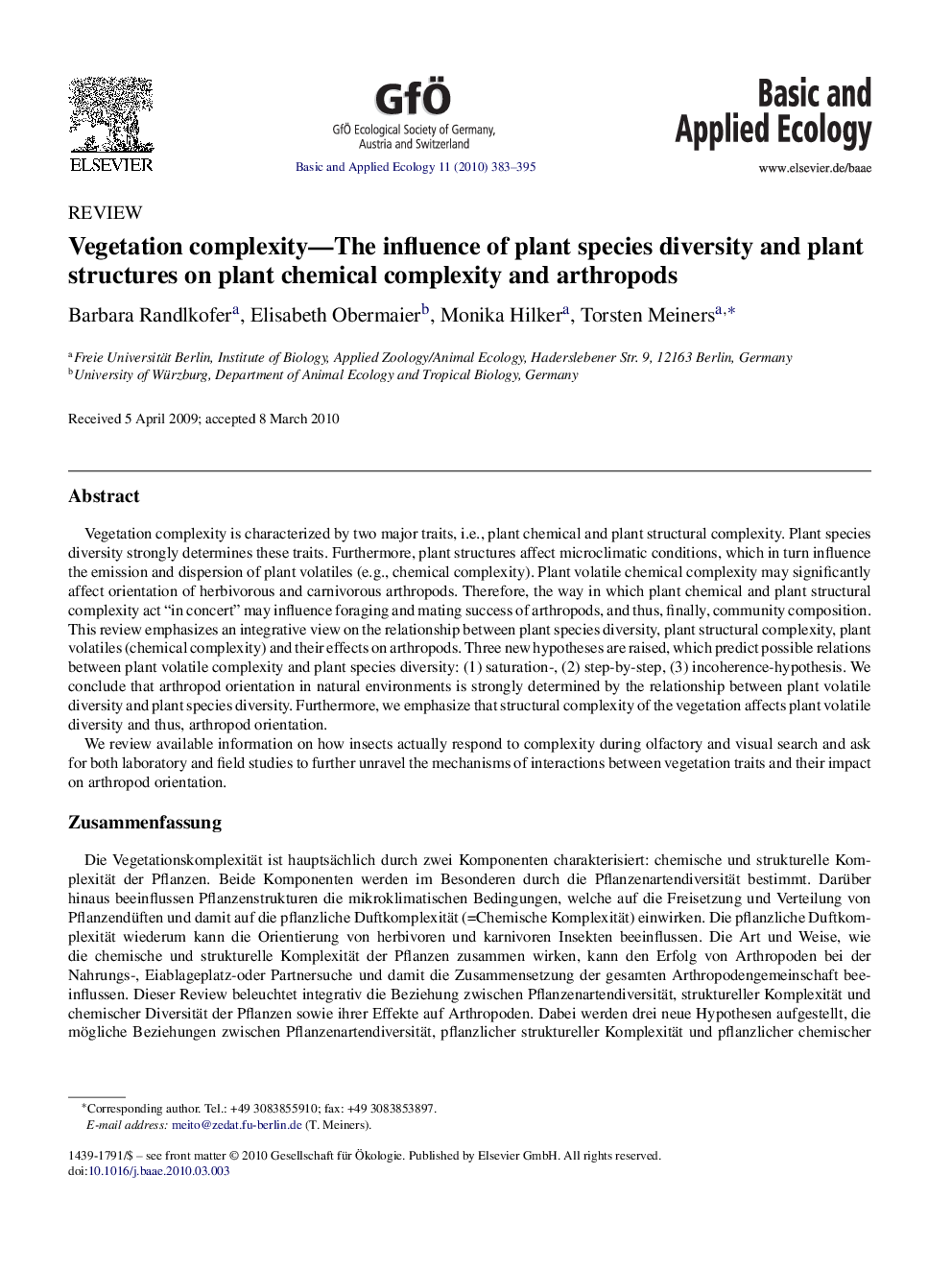| کد مقاله | کد نشریه | سال انتشار | مقاله انگلیسی | نسخه تمام متن |
|---|---|---|---|---|
| 4384561 | 1304422 | 2010 | 13 صفحه PDF | دانلود رایگان |

Vegetation complexity is characterized by two major traits, i.e., plant chemical and plant structural complexity. Plant species diversity strongly determines these traits. Furthermore, plant structures affect microclimatic conditions, which in turn influence the emission and dispersion of plant volatiles (e.g., chemical complexity). Plant volatile chemical complexity may significantly affect orientation of herbivorous and carnivorous arthropods. Therefore, the way in which plant chemical and plant structural complexity act “in concert” may influence foraging and mating success of arthropods, and thus, finally, community composition. This review emphasizes an integrative view on the relationship between plant species diversity, plant structural complexity, plant volatiles (chemical complexity) and their effects on arthropods. Three new hypotheses are raised, which predict possible relations between plant volatile complexity and plant species diversity: (1) saturation-, (2) step-by-step, (3) incoherence-hypothesis. We conclude that arthropod orientation in natural environments is strongly determined by the relationship between plant volatile diversity and plant species diversity. Furthermore, we emphasize that structural complexity of the vegetation affects plant volatile diversity and thus, arthropod orientation.We review available information on how insects actually respond to complexity during olfactory and visual search and ask for both laboratory and field studies to further unravel the mechanisms of interactions between vegetation traits and their impact on arthropod orientation.
ZusammenfassungDie Vegetationskomplexität ist hauptsächlich durch zwei Komponenten charakterisiert: chemische und strukturelle Komplexität der Pflanzen. Beide Komponenten werden im Besonderen durch die Pflanzenartendiversität bestimmt. Darüber hinaus beeinflussen Pflanzenstrukturen die mikroklimatischen Bedingungen, welche auf die Freisetzung und Verteilung von Pflanzendüften und damit auf die pflanzliche Duftkomplexität (=Chemische Komplexität) einwirken. Die pflanzliche Duftkomplexität wiederum kann die Orientierung von herbivoren und karnivoren Insekten beeinflussen. Die Art und Weise, wie die chemische und strukturelle Komplexität der Pflanzen zusammen wirken, kann den Erfolg von Arthropoden bei der Nahrungs-, Eiablageplatz-oder Partnersuche und damit die Zusammensetzung der gesamten Arthropodengemeinschaft beeinflussen. Dieser Review beleuchtet integrativ die Beziehung zwischen Pflanzenartendiversität, struktureller Komplexität und chemischer Diversität der Pflanzen sowie ihrer Effekte auf Arthropoden. Dabei werden drei neue Hypothesen aufgestellt, die mögliche Beziehungen zwischen Pflanzenartendiversität, pflanzlicher struktureller Komplexität und pflanzlicher chemischer Diversität vorhersagen: (1) Sättigungs-, (2) Stufenmodell-, (3) Inkohärenz-Hypothese. Wir kommen dabei zum Schluss, dass die Orientierung von Arthropoden in natürlichen Umwelten durch den Zusammenhang von Pflanzenartendiversität und pflanzlicher Duftdiversität der Vegetation bestimmt wird. Es bedarf weiterer Untersuchungen in Labor und Freiland um die Mechanismen der Interaktionen zwischen diesen Merkmalen der Vegetation und ihrer Wirkung auf die Orientierung von Arthropoden aufzuklären.
Journal: Basic and Applied Ecology - Volume 11, Issue 5, August 2010, Pages 383–395